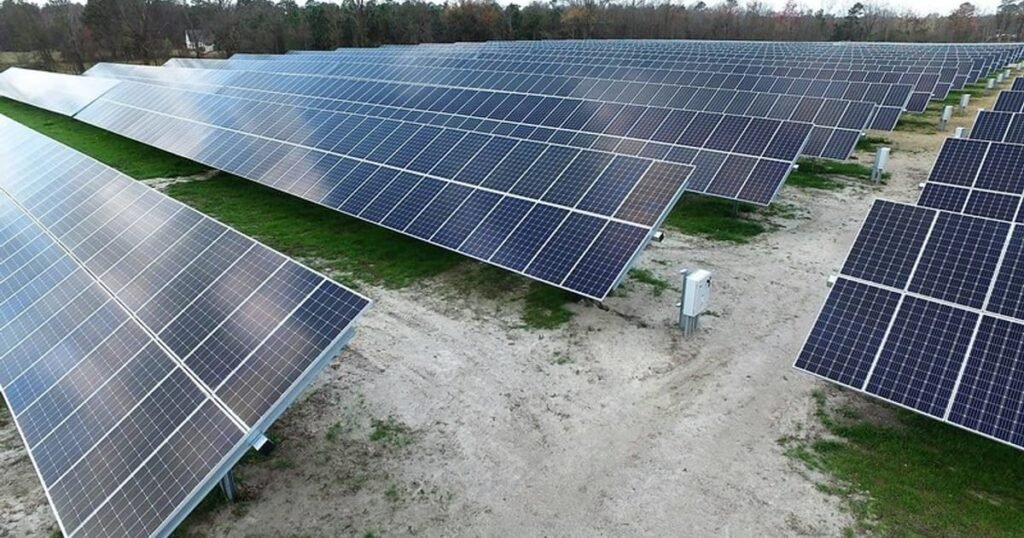A question of ‘regulatory surplus’
For large customers with 100% clean energy commitments, a green tariff is a necessity in North Carolina, where Duke has a monopoly and cities, data centers, and the like can’t buy clean energy directly from solar farms.
In theory, a green tariff allows a company such as Google or Amazon to spur a new supply of clean energy equal to its electric demand, with Duke acting as an administrative go-between. An earlier iteration of Green Source Advantage more or less did just that.
But the accounting got more complicated in 2021, when a bipartisan state law required Duke to cut its carbon pollution by at least 95% by 2050. If the company is legally required to build scores of solar farms anyway, can a large customer legitimately claim its sponsorship of one project makes a difference?
This question of “regulatory surplus” sparked a flurry of arguments and counterarguments before the commission for some 18 months. Duke initially claimed such “additionality” was neither feasible nor necessary, and some businesses said chipping in to support the clean energy transition was good enough for them. More than a dozen local chambers of commerce and potential customers wrote to regulators in support of the original program.
But Google, the U.S. Department of Defense, and other large customers joined clean energy advocates to flag the problem of regulatory surplus, as did the Center for Resource Solutions, the nonprofit that certifies voluntary renewable energy purchase programs. Duke University, which has no connection to the utility, said it wouldn’t participate in the tariff.
‘A small step in the right direction’
The debate, along with prodding from commissioners, prompted Duke Energy to add a “resource acceleration option” to its proposal. The alternative allows large customers to advance about 150 megawatts of solar energy each year by sponsoring projects not selected in the company’s annual competitive bidding process. Every two years, Duke gets retroactive credit for this “extra” solar as part of its compliance with the 2021 law.
Clean energy advocates believe the new option is a “small step in the right direction.” But they note it accounts for 1 gigawatt of clean energy over 10 years, a fifth of the entire program. Customers who lay claim to the remaining 4 gigawatts would not be impacting the state’s transition to clean electricity, they say.
“If you’re the customer of a business who claims to support our state’s clean energy transition by participating in the program, you’re going to expect that business to be making a difference — not just subsidizing what Duke was going to do anyway,” said Nick Jimenez, senior attorney at the Southern Environmental Law Center.
The Carolinas Clean Energy Business Alliance, a group of clean energy suppliers, also criticized the acceleration option. And though the Carolina Utility Customers Association, another group of large industrial customers, didn’t oppose the amended proposed tariff, it registered skepticism.
“[Our] members have little interest in the Resource Acceleration Option,” the group said in a letter to regulators, “which would deliver electricity at a premium cost without providing the benefit of regulatory surplus-based environmental attributes that would be useful in meeting corporate environmental, social, and governance goals.”
Cause for hope?
While advocates see little good in the commission’s approval of the Green Source Advantage Choice program, they still have some faint cause for hope.
One is the so-called Clean Transition Tariff, which Duke could propose later this year. An outgrowth of a May agreement between the utility and Amazon, Google, Microsoft, and Nucor, that program could allow participating customers to spur new projects, such as solar–battery storage combos or small nuclear energy, that provide carbon-free electricity around the clock.
“This is not within the order,” said Jimenez, but the May memorandum of understanding, “is the big opportunity for something better.”
Duke says the Clean Transition Tariff would be another voluntary option for customers, not a replacement for the one just greenlighted. “We see the approval of Green Source Advantage Choice as a first step,” the company’s Stewart said, “enabling us to move forward with new tariffs like the Clean Transition Tariff.”
Maggie Shober, research director at the Southern Alliance for Clean Energy, agrees the memorandum of understanding is cause for some optimism. But she also notes that it’s only “an agreement to talk about something. It could be an opportunity,” she said, “or it could be a missed opportunity. “
And no matter what, the Clean Transition Tariff won’t cater to municipalities and other midsize customers with climate commitments. If these customers decline to pursue Green Source Advantage Choice, their only option is to wait for Duke to adjust.
Commissioner Jeffrey A. Hughes pointed to that possibility in a concurring opinion.
“Once the program offerings are launched, it will quickly become clear whether the program is as attractive as Duke asserts,” Hughes wrote. “If concerns continue and interest is modest from the outset, it is my hope that Duke will work quickly on new programs that will have a greater impact.”

